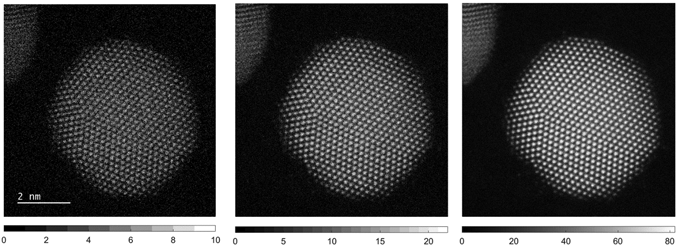Crossref Citations
This article has been cited by the following publications. This list is generated based on data provided by
Crossref.
Dwyer, Christian
2021.
Quantitative annular dark-field imaging in the scanning transmission electron microscope—a review.
Journal of Physics: Materials,
Vol. 4,
Issue. 4,
p.
042006.
Mullarkey, Tiarnan
Peters, Jonathan J P
Downing, Clive
and
Jones, Lewys
2022.
Using Your Beam Efficiently: Reducing Electron Dose in the STEM via Flyback Compensation.
Microscopy and Microanalysis,
Vol. 28,
Issue. 4,
p.
1428.
Mullarkey, Tiarnan
Peters, Jonathan JP
Moldovan, Grigore
Garel, Jonathan
and
Jones, Lewys
2022.
Fast Solid-state Segmented Detectors: Improvements and Implications for DPC-STEM.
Microscopy and Microanalysis,
Vol. 28,
Issue. S1,
p.
2486.
Peters, Jonathan J P
Mullarkey, Tiarnan
and
Jones, Lewys
2022.
Improving the Noise Floor and Speed of Your Detector: A Modular Hardware Approach for Under $1000.
Microscopy and Microanalysis,
Vol. 28,
Issue. S1,
p.
2904.
Mullarkey, Tiarnan
Peters, Jonathan J P
Geever, Matthew
and
Jones, Lewys
2022.
How Low Can You Go: Pushing the Limits of Dose and Frame-time in the STEM.
Microscopy and Microanalysis,
Vol. 28,
Issue. S1,
p.
2218.
Quigley, Frances
McBean, Patrick
O'Donovan, Peter
Peters, Jonathan J P
and
Jones, Lewys
2022.
Cost and Capability Compromises in STEM Instrumentation for Low-Voltage Imaging.
Microscopy and Microanalysis,
Vol. 28,
Issue. 4,
p.
1437.
Gambini, Laura
Mullarkey, Tiarnan
Jones, Lewys
and
Sanvito, Stefano
2023.
Machine-learning approach for quantified resolvability enhancement of low-dose STEM data.
Machine Learning: Science and Technology,
Vol. 4,
Issue. 1,
p.
015025.
Esser, Bryan D.
and
Etheridge, Joanne
2023.
Complementary ADF-STEM: a Flexible Approach to Quantitative 4D-STEM.
Ultramicroscopy,
Vol. 243,
Issue. ,
p.
113627.
Peters, Jonathan J P
Reed, Bryan W
Jimbo, Yu
Porter, Alexandra
Masiel, Daniel
and
Jones, Lewys
2023.
A New Low-dose STEM Imaging Mode with Probability Driven Intra-pixel Beam Blanking.
Microscopy and Microanalysis,
Vol. 29,
Issue. Supplement_1,
p.
1754.
Peters, Jonathan J P
Mullarkey, Tiarnan
Gott, James A
Nelson, Elizabeth
and
Jones, Lewys
2023.
Interlacing in Atomic Resolution Scanning Transmission Electron Microscopy.
Microscopy and Microanalysis,
Vol. 29,
Issue. 4,
p.
1373.
Mullarkey, Tiarnan
Geever, Matthew
Peters, Jonathan J P
Griffiths, Ian
Nellist, Peter D
and
Jones, Lewys
2023.
How Fast is Your Detector? The Effect of Temporal Response on Image Quality.
Microscopy and Microanalysis,
Vol. 29,
Issue. 4,
p.
1402.
Bekkevold, Julie Marie
Peters, Jon J P
Mullarkey, Tiarnan
and
Jones, Lewys
2023.
Retrofitting and Reconfiguring Existing Microscopes for Digital DPC: an Accessible Approach to Low-Dose Phase Mapping.
Microscopy and Microanalysis,
Vol. 29,
Issue. Supplement_1,
p.
1878.
Ophus, Colin
2023.
Quantitative Scanning Transmission Electron Microscopy for Materials Science: Imaging, Diffraction, Spectroscopy, and Tomography.
Annual Review of Materials Research,
Vol. 53,
Issue. 1,
p.
105.
Peters, Jonathan J. P.
Mullarkey, Tiarnan
Hedley, Emma
Müller, Karin H.
Porter, Alexandra
Mostaed, Ali
and
Jones, Lewys
2023.
Electron counting detectors in scanning transmission electron microscopy via hardware signal processing.
Nature Communications,
Vol. 14,
Issue. 1,
Kievits, Arent J.
Duinkerken, B.H. Peter
Fermie, Job
Lane, Ryan
Giepmans, Ben N.G.
and
Hoogenboom, Jacob P.
2024.
Optical STEM detection for scanning electron microscopy.
Ultramicroscopy,
Vol. 256,
Issue. ,
p.
113877.
Lobato, I.
Friedrich, T.
and
Van Aert, S.
2024.
Deep convolutional neural networks to restore single-shot electron microscopy images.
npj Computational Materials,
Vol. 10,
Issue. 1,






